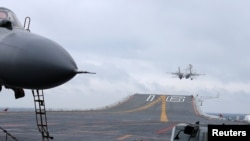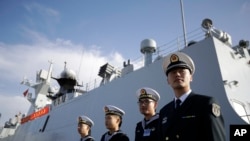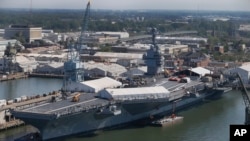During his visit to Asia, U.S. Defense Secretary Jim Mattis said the U.S. is committed to “freedom of navigation” in the disputed waters in the South China Sea. But, he ruled out a military response.
Mattis said to reporters in Tokyo, “At this time, we do not see any need for dramatic military moves at all.”
Tension between U.S. and China
Last December, China conducted takeoff and landing drills from its aircraft carrier Liaoning in the South China Sea, according to the state news agency Xinhua. The move followed a phone call between then President-elect Donald Trump and the president of Taiwan. China has long considered Taiwan as a province of China.
During his confirmation hearing, Rex Tillerson, the new U.S. Secretary of State, called China’s island building an “illegal” activity. He said, “We’re going to have to send China a clear signal that, first, the island-building stops; and, second, your access to those islands also is not going to be allowed.”
The comment drew sharp reaction from China. Lu Kang is a spokesman for China’s Foreign Ministry. In his daily briefing on Jan. 12, he said that China “has full right to conduct any kind of normal activities on its own territory within its sovereignty.”
The Global Times is a state-run news organization. It published a strongly worded editorial saying, “Unless Washington plans to wage a large-scale war in the South China Sea, any other approaches to prevent Chinese access to the islands will be foolish.”
China’s military capabilities
Military experts say China’s current military capabilities do not measure up to Beijing’s tough rhetoric on its continuing activities in the South China Sea.
Jeffrey Engstrom is a senior policy analyst at the RAND Corporation.
“Certainly things are more tense than they were just a few weeks ago. But I still don’t think we’re quite at the point of crisis, and certainly not at immediate confrontation.”
Engstrom said China’s navy is not nearly as well equipped as the United States.
The Liaoning is the only aircraft carrier in the Chinese naval fleet. It was first built for the Soviet navy and launched in Ukraine in 1988, but was never fully completed. It was upgraded and modernized for the People’s Liberation Army (PLA) Navy, which launched it in 2012.
The Liaoning is smaller than U.S. aircraft carriers and cannot support as many aircraft. It also has a “ski jump” type of system for launching aircraft instead of a catapult system. This limits the size of aircraft that can be launched, as well as how many weapons can be loaded onto the aircraft.
According to the U.S.-based research group the Center for Strategic and International Studies (CSIS), the Liaoning can carry up to 24 fighter jets and about 12 helicopters.
The U.S. Navy’s current Nimitz-class warships can handle more than 60 aircraft. One of these is the USS Ronald Reagan, stationed in Japan.
Since the Liaoning has only been fully operational for a few years, it also remains behind the U.S. Navy in experience and training.
Denny Roy is a senior fellow at the Hawaii-based East-West Center. He says China is getting a lot of experience using the Liaoning while building its own new carrier fleet.
“We understand that the Liaoning is primarily meant for training. Learning to operate an aircraft carrier takes many years, it’s extremely complicated. So it’s reasonable that the Chinese would start with a practice carrier, with the training wheels.”
Roy added that China is thought to be currently working on additional, more advanced aircraft carriers.
“We think there are more Chinese carriers under construction that will be larger, more capable - and these are intended to actually be prepared to fight.”
However, he added that even China’s carriers currently under construction will not have the same capacity as the new U.S. super carriers.
The United States is currently building a new class of aircraft carriers known as the Gerald R. Ford class. These $13 billion super carriers are even bigger than the Nimitz class. They can carry more than 4,500 people and at least 75 aircraft. The first of these, the USS Gerald Ford, is expected to be put into service in 2017.
Jeffrey Engstrom says despite the Liaoning’s limited capabilities, it serves as an important symbol of progress for China’s navy.
“The symbolism is that China is a great power. Great powers have aircraft carriers, and China too has an aircraft carrier.”
I’m Bryan Lynn.
Bryan Lynn reported this story for VOA Learning English, with additional material coming from VOA News, the Associated Press and Reuters. Hai Do was the editor.
We want to hear from you. Write to us in the Comments section, and visit our Facebook page.
________________________________________________________________
Words in This Story
navigation - n. process by which ships are successfully guided through water
drill – n. training activity conducted by soldiers
approach – n. way of doing something
rhetoric - n. language intended to influence people that might not be honest or reasonable
fleet – n. a group of ships in a country’s navy
ski jump – n. a jump used by skiers to lift them into the air
catapult – n. device for launching a plane from the deck of an aircraft carrier
training wheels – n. small wheels attached to the back of a bicycle when someone is learning to ride it












